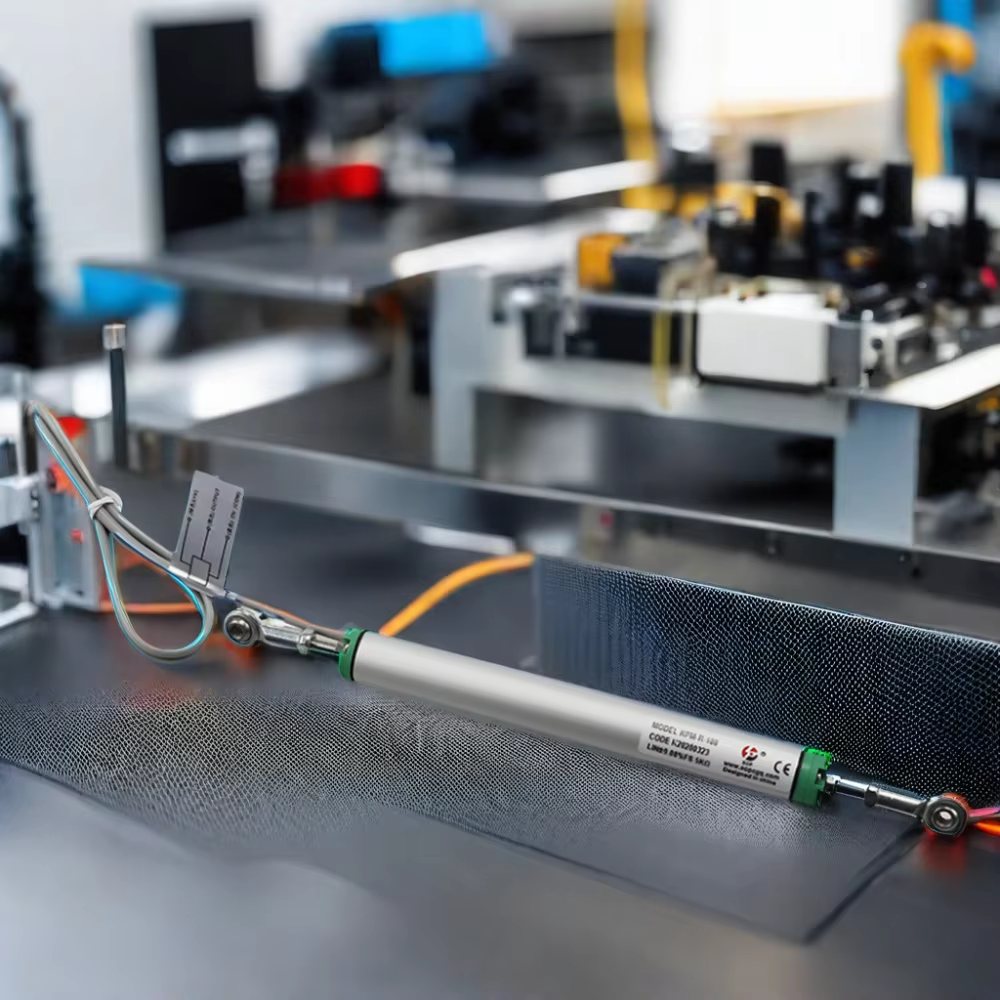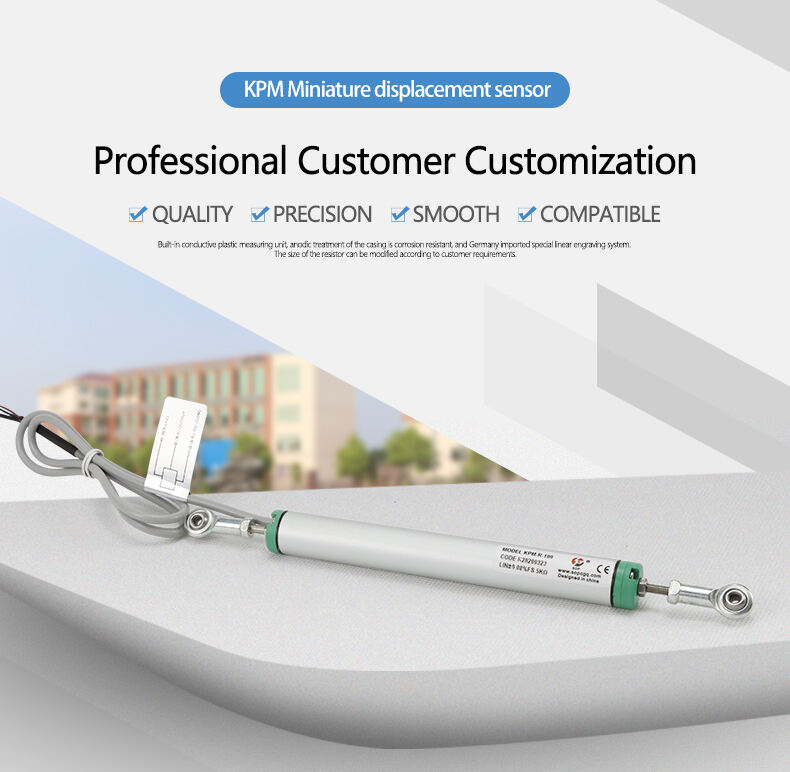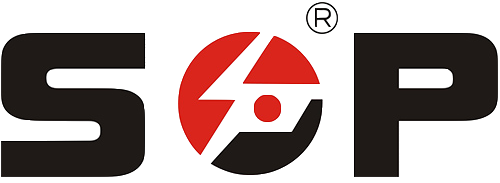لینیئر ڈسپلیسمنٹ سینسرز میں عمدہ درستگی
سب مائیکرون ریزولوشن خصوصیات
آج کے خطی جابجایی سینسرز ذیلی مائیکرون رزولوشن کے مشاہدات فراہم کر سکتا ہے جو 0.1 مائیکرون تک کی منتقلی کو واضح کرنے کے لیے درکار ہوتے ہیں، درستگی کا یہ معیار سیمی کنڈکٹر لیتھوگرافی اور آپٹیکل کمپونینٹس کی تیاری جیسی صنعتوں کے لیے نہایت اہم ہے، جنہیں منٹو میٹر برداشت کے اندر کام کرنا ہوتا ہے تاکہ پروڈکٹ کی معیار کو یقینی بنایا جا سکے۔ غیر رابطہ والے LVDT سینسر (جیسا کہ ایج-آف-دی-آرٹ ڈیٹیکشن سسٹمز کی ادب میں دکھایا گیا ہے) پہننے اور پھٹنے کے لیے بےحس ہوتے ہیں اور زیادہ درستگی کے ساتھ کام کرتے ہیں، انہیں زیادہ حجم والے پروڈکشن ماحول میں ہر وقت استعمال کے لیے موزوں بناتے ہیں۔ 2023 کی ایک مطالعہ سے پتہ چلا کہ خودرو کیم شافٹ کی تشکیل میں روایتی مائیکرومیٹرز کے مقابلے میں زیادہ رزولوشن (<1 مائیکرون) سینسرز پوزیشن کی غلطیوں کو 32% تک کم کر دیتے ہیں۔
درجہ حرارت کے مطابق ماپنے کے نظام
حرارتی ڈرِفٹ صنعتی پیمائش کی غلطیوں کے 55% کی ذمہ دار ہے (پونمون انسٹی ٹیوٹ 2023)۔ جدید حساس ترین سینسرز میں حقیقی وقت کے درجہ حرارت کی بروئے کار معاوضہ کے خوارزمیات شامل ہوتے ہیں جو آن بورڈ حرارتی سینسر کے ڈیٹا کا استعمال کرتے ہوئے پیمائشوں کو معیاری بناتے ہیں۔ اس ٹیکنالوجی کا استعمال کرتے ہوئے ہائیڈرولک سلنڈر مانیٹرنگ سسٹمز نے مثال کے طور پر قطبی تیل کی کھدائی کے ٹیسٹوں میں –40°;C سے 85°;C تک ±0.02% درستگی فراہم کی، ہائیڈرولک سلنڈر مانیٹرنگ سسٹمز۔ آج کے دور میں سیرامک سابسٹریٹ مواد جس کی حرارتی پھیلاؤ کی شرح < 5ppm/ °;C ہے، کو اس طرح کے خوارزمیات کے ساتھ ملا کر استعمال کیا جاتا ہے۔
کیس سٹڈی: سنی CNC مشیننگ میں درستگی
ایک ٹائر 1 فضائی وسائل کے سپلائر نے 52 سنی mills ملز پر درجہ حرارت کے مطابق لکیری سینسرز نافذ کیے، حاصل کیا:
| میٹرک | ترقی | ماخذ |
|---|---|---|
| حصہ برداشت | ±3 µm – ±1.2 µm | اندرونی معیاری قبولیت (2024) |
| اوزار کی پہنائو کا پتہ چلانا | 18% تیز | پروڈکشن لاگز |
| کچرا شرح | 2.1% – 0.9% | مالی رپورٹس |
سسٹم کی مشین لرننگ کیلیبریشن نے ٹائیٹینیم مکھنائزنگ سائیکلوں کے دوران خود بخود غلطی کی اصلاح کو فعال کر دیا، جس سے ہفتہ وار دستی کیلیبریشن کے کام میں 14 گھنٹوں کی کمی واقع ہوئی۔ یہ نفاذ یہ ظاہر کرتا ہے کہ تھرملی طور پر غیر مستحکم مینوفیکچرنگ کے ماحول میں درستگی برقرار رکھنے کے لیے صنعت کے اہم چیلنج کا مقابلہ کرنے میں ذیلی مائیکرون سینسرز کیسے مدد کرتے ہیں۔
لکیری تبدیلی کے سینسرز کے صنعتی استعمالات
خودرو اسمبلی لائن کی پوزیشننگ
خطی جابجایی سینسرز روبوٹ کی ویلڈنگ اور چپکنے والے مادہ کے اطلاق میں ±0.05 ملی میٹر تک ملانے کی غلطیوں کو کم کرنا۔ یہ سینسر ملٹی ایکسس پینٹ روبوٹس میں روبوٹ کو کنٹرول کرتے ہیں تاکہ نوزل سے پینل کے درمیان فاصلہ مستقل رہے، جس سے زائد اسپرے کے ضائع ہونے میں 18% کی کمی واقع ہوتی ہے (Precison Manufacturing Quarterly 2023) ذیلی ملی سیکنڈ ردعمل کا وقت تیز حرکت کرنے والے کمپونینٹ ٹرانسفرز کے دوران بلاتاخیر ایڈجسٹمنٹس کے قابل بناتا ہے جو 60 کاروں / گھنٹہ سے زیادہ کی خودرو پیداوار کی شرح حاصل کرنے کے لیے ناگزیر ہے۔

بھاری مشینری میں ہائیڈرولک سلنڈر کی نگرانی
بھاری بوجھ والے LVDT سینسرز ہائیڈرولک نظام کے پسٹن کی پوزیشنوں کو توانائی کے مطابق 25 MPa تک ماپتے ہیں۔ اس فوری رائے سے بچاؤ ممکن ہوگا کہ جب ایکسکیویٹر آرم میں ناکامی واقع ہو، اگر اُس وقت راڈ مرکز سے ہٹ کر ہو، اور 0.001 ملی میٹر تک کی حساسیت کے ذریعے اس کا پتہ لگایا جاسکتا ہے۔ اگر شفٹ سینسرز اور پیشگو مینٹیننس الگورتھم استعمال کئے جائیں تو بھاری مشینری کے غیر منصوبہ بند بندوبست میں 37% کمی لائی جاسکتی ہے (ارتموونگ ٹیک ان سائٹس 2024)
سیمی کنڈکٹر وافر اسٹیج کنٹرول
میگنیٹو سٹرکٹو لینیئر سینسرز لیتھو گرافی اسٹیجز میں 5 نینو میٹر کی پوزیشننگ درستگی حاصل کرتے ہیں - جو ذیل دس نینو میٹر مائیروچپس کی پیداوار کے لیے ضروری شرط ہے۔ الومینیم وافر اسٹیجز میں حرارتی پھیلاؤ کی بھرتی کے ذریعے، یہ سینسر اوور لے کی ہم آہنگی کی غلطیوں کو 2.5 نینو میٹر سے کم رکھنے میں مدد کرتے ہیں، جس سے زیادہ حجم والی تیاری فیسلٹیز میں سیمی کنڈکٹر کی پیداوار متاثر ہوتی ہے۔
غیر رابطہ لکیری سینسر کے فوائد
ایڈی کرنٹ اور آپٹیکل پیمائش کے نظام
[0024] غیر رابطہ لکیری نقل و حمل سینسر میں دھارا کیمیت یا آپٹیکل پیمائش کی تکنیکوں کو شامل کیا جاتا ہے تاکہ مقام کو درستگی سے ٹریس کیا جا سکے۔ دھارا کیمیت، دھارا کیمیت سینسرز میں استعمال ہوتی ہے جو ±0.1% درستگی کے ساتھ تیل، دھول، یا درجہ حرارت متغیر ماحول میں موصل اہداف کی تلاش کے لیے الیکٹرو میگنیٹک فیلڈ کا استعمال کرتے ہیں (سینسر جرنل...2023)۔ دیگر آپٹیکل متبادل، جیسے لیزر مثلث نظام، عکاس سطح پر ذرہ از ذرہ قرارداد فراہم کرتے ہیں، لیکن صرف تب جب دھول بھرے ماحول میں کام نہ کر رہے ہوں۔ دھارا کیمیت کی تکنیک کو میٹل ورکنگ اطلاقات کے لیے تیزی سے اپنا لیا گیا ہے، صنعتی سینسرز میں سے 78% اب غیر رابطہ ذرائع سے کام کرتے ہیں (Precison Engineering Report, 2024)۔

بے کمی کارکردگی مسلسل نگرانی میں
غیر رابطہ سینسرز، چاہے وراثتی ہوں یا غیر فعال، کے اجزاء کے درمیان کوئی مکینیکل رابطہ نہیں ہوتا، لہذا پہننے اور پھٹنے کا کوئی نقصان نہیں ہوتا اور کچھ ماڈلوں کو آپریٹنگ مدت کے لحاظ سے ہائی وائبریشن ماحول میں 100,000 گھنٹوں تک یا اس سے زیادہ درجہ بندی دی گئی ہے۔ 2023 میں مرمت کے ایک تجزیہ سے پتہ چلا کہ 5 سال کے دوران پوٹینشیومیٹرک سینسرز کے مقابلے میں کیلیبریشن ڈرِفٹ میں 63% کمی آئی۔ یہ قابل بھروسہ طیارہ سازی کے شعبے کے لیے انتہائی اہم ہے جہاں مستقل پوزیشن فیڈبیک کمپوزٹ لے اپ ایپلی کیشنز میں مائکرو نقائص کو روکتا ہے۔ حرارتی استحکام بھی اس میں شامل ہے، جس میں دھارا کے نظام سیلسیئس کے منفی 40°C سے مثبت 150°C کے درمیان ±5 مائیکرون کی درستگی برقرار رکھتے ہیں، دوبارہ کیلیبریشن کی ضرورت کے بغیر۔
انڈکٹو لینیئر ڈسپلیسمنٹ سینسر کی صلاحیتیں
خُشک ماحول کی کارکردگی کے معیارات
انڈکٹو لینیئر ڈسپلیسمنٹ سینسرز -40 سے +125°C تک درجہ حرارت کی حد میں ±0.1% FS درستگی فراہم کرتے ہیں، اور ان کی استحکام حرارتی سائیکلنگ سے متاثر نہیں ہوتا۔ ایک ہربھیج سیل شدہ 316L سٹینلیس سٹیل کے خول اور IP67 داخلہ درجہ بندی کے ساتھ، یہ نمی، دھول اور کیمیکلز کی وجہ سے کھرچنے اور ناکامی کو برداشت کر سکتے ہیں- سٹیل ملز، آف شور ڈرلنگ، اور رگس کے لیے ضرورت کی چیز۔ 2023 کے میدانی تجرباتی مقام پر سیمنٹ پیداواری پلانٹس میں 98.6% وقت تناؤ کی سطح 15 g/m³ سے زیادہ ہونے کے باوجود گزارا، جو آپٹیکل سینسرز کے مقابلے میں 34% زیادہ وقت تھا۔ دھارا-کرنٹ پر مبنی ماڈلز بلند کمپن والے ماحول (15g RMS تک ٹیسٹ کیا گیا) میں مکینیکل پہننے سے متاثر نہیں ہوتے، اور دوبارہ کیلیبریشن کے بغیر 100 ملین سائیکل کی عمر فراہم کرتے ہیں۔
آئل اینڈ گیس پائپ لائن انٹیگریٹی مانیٹرنگ
سینسر پائپ لائنوں کے اندر مائیکرو میٹر ڈسپلیسمنٹ تبدیلیوں کو سمجھتے ہیں، اور پائپ لائن میں بکلنگ خطرات کا پتہ لگانے کے لیے استعمال کیے گئے تھے جو 5000 psi تک دباؤ کی تبدیلی کا سامنا کر رہے تھے۔ سبسی انڈکٹو اینچر مانیٹرنگ سسٹم 3000 میٹر سے زیادہ گہرائی اور 0.01 µm/ماہ سے کم ڈرِفٹ ریٹس پر اینچر سلپیج کی نگرانی کے لیے ثابت شدہ، آلے کے ذریعہ مددگار طریقہ فراہم کرتا ہے۔ آرکٹک LNG ٹرمینلز پر مقامی ٹیسٹوں نے حال ہی میں -55°C حرارتی تقلص واقعات کے دوران API 1173 یا ISO 10816 کے مطابق 99.4% رساو کا پتہ لگانے کی درستگی حاصل کی ہے۔ غیر رابطہ آپریشن سیل کے پہننے کو ختم کر دیتا ہے-24/7 مانیٹرنگ ایپلی کیشنز میں استعمال ہونے والے LVDT پروبز کے مقابلے میں یہ ایک واضح فائدہ ہے۔
لینیئر ڈسپلیسمنٹ سینسر کی قسموں کا انتخاب
صحیح لکیری تبدیلی سینسر کا انتخاب تکنیکی خصوصیات اور آپریشنل تقاضوں کے درمیان توازن قائم کرنے کا متقاضی ہوتا ہے۔ سینسرز کو پیمائش کی حد، ماحولیاتی حالات، اور آؤٹ پٹ کی ضروریات کے ساتھ ہم آہنگ ہونا چاہیے اور ساتھ ہی لاگت اور دیرپائیگی کے مسائل کا بھی خیال رکھنا چاہیے۔ مثال کے طور پر، مائیکرو میٹر پوزیشننگ کے کام مختلف ٹیکنالوجیز کے متقاضی ہوتے ہیں جو میٹر سکیل والی صنعتی نگرانی کے لیے استعمال ہوتی ہیں۔
LVDT بمقابلہ میگنیٹو سٹرکٹو سینسر کا موازنہ
| پیرامیٹر | LVDT سینسروں | میگنٹو سٹرائیکٹوائی سینسرز |
|---|---|---|
| ٹیکنالوجی | کنٹیکٹ پر مبنی الیکٹرومیگنیٹک انڈکشن | غیر رابطہ میگنیٹک ویو پروپیگیشن |
| عمومی حد | ±2 ملی میٹر – ±500 ملی میٹر | 50 ملی میٹر – 20,000 ملی میٹر |
| صحت | ±0.1% مکمل اسکیل (FS) | ±0.01% FS |
| ماحولیاتی موزوں پن | شدید کمپن، شدید درجہ حرارت | داغدار مائعات، دھماکہ خیز فضا |
LVDTs اپنی مضبوط تعمیر کی وجہ سے خشک ماحول میں بہترین کارکردگی کا مظاہرہ کرتے ہیں، جبکہ میگنیٹو سٹرکٹو سینسرز ہائیڈرولک نظام کے لیے مناسب غیر رابطہ آپریشن فراہم کرتے ہیں۔ ا حالیہ صنعتی سینسر کے انتخاب کا جائزہ lVDTs کو دھاتی تشکیل دینے والے پریسوں کے لیے ترجیحی قرار دیتا ہے، جبکہ میگنیٹو سٹرکٹو اقسام آف شور آئل پلیٹ فارم کی نگرانی میں سب سے زیادہ استعمال ہوتی ہیں۔
وضاحت کا مقابلہ ناپ کی حد سے
اعلیٰ وضاحت والے سینسرز (مثال کے طور پر آپٹیکل انکوڈرز 5 نینو میٹر وضاحت کے ساتھ) عام طور پر مختصر ناپ کی حد (<100 ملی میٹر) کی حمایت کرتے ہیں، جبکہ طویل فاصلے کے انڈکٹو سینسرز (1,000 ملی میٹر تک) ±0.5% FS درستگی حاصل کرتے ہیں۔ خودکار اسمبلی روبوٹس 200 ملی میٹر کی حد میں ±0.01 ملی میٹر وضاحت کو ترجیح دیتے ہیں، جبکہ بند کی تبدیلی کی نگرانی کے نظام 10 میٹر کے فاصلے پر ±1 ملی میٹر درستگی قبول کرتے ہیں۔
صنعتی فرار: اینالاگ اور ڈیجیٹل آؤٹ پٹ بحث
بھلے ہی اُدْیو 4.0 کی بڑھتی ہوئی مانگ کے باعث بھاری صنعتوں میں رجسٹرڈ تبدیلی سینسرز میں سے 62 فیصد اب بھی اینالاگ (4–20 mA یا 0–10 V) ہیں۔ وراثتی حمایت اور شور کی مزاحمت اس رجحان کو برقرار رکھنے کی ایک وجہ ہے، جبکہ نیم درخشاں بنیادیں (IO-Link, CANopen) میں حقیقی وقت کے ڈیٹا انضمام کے لیے زیادہ مقبول ہو رہی ہیں۔ یہ تضاد ترجیحات کے دباؤ کو ظاہر کرتا ہے: اینالاگ آسانی کے مقابلے میں ڈیجیٹل تشخیص
لکیری تصویر سینسر کی ترقیات
زرعی سطح کی جانچ پڑتال کی نظام
لائن سکین کی بنیاد پر زرعی سطح کی جانچ پڑتال کے نظام حقیقی وقت میں خامیوں کی پہچان کی اجازت دیتے ہیں جن کی رفتار 10 میٹر/سیکنڈ سے زیادہ ہوتی ہے اور پکسل ریزولوشن 63.5 µm (400 DPI) تک ہوتی ہے۔ یہ سینسر چمکدار دھاتوں سے لے کر متن کیمیائی مرکبات تک ہر چیز میں ذیلی مائیکرون خامیوں کا پتہ لگاتے ہیں، جبکہ کم روشنی والے صنعتی ماحول میں 100 لوکس تک کام کر رہے ہوتے ہیں۔ نئی بہتر پکسل جیومیٹری 7، 8 روشنی کی حساسیت کو 40 فیصد تک بڑھا دیتی ہے، اس کا مطلب ہے کہ 9 حصہ بغیر تعطل کے چلنے والے مینوفیکچرنگ ماحول میں استعمال کیا جا سکتا ہے۔
نئی ترقیات 400-980nm تک طیفی حساسیت کو وسیع کر دیتی ہیں، جس سے کثیر مواد کے معائنے کے لیے واحد سینسر حل یقینی ہوتا ہے۔ 2024 کے لیے ایک آپٹیکل سینسر کے مطالعے نے ظاہر کیا کہ بہترین نظاموں سے فی پارٹ معائنے کے وقت میں ایریا-اسکین نظاموں کے مقابلے میں 25% کمی واقع ہوتی ہے اور 24/7 پیداوار لائن پر 99.98% درستگی حاصل ہوتی ہے۔ سیمی کنڈکٹر وافر کی قطار بندی اور خودرو مینوفیکچرنگ میں پینٹ کی معیاری کنٹرول جیسی درخواستوں کے لیے یہ صلاحیت بہت اہم ہے۔
بیرونی پیمائش میں مستقبل کے رجحانات
آئی او ٹی کیلئے پریڈکٹو مینٹیننس کے لیے تکامل
آئی او ٹی کے ذریعے بیرونی پیمائش کے نظاموں کے ساتھ ضم شدہ صنعتی مرمت کے نقطہ ہائے نظر کو تبدیل کر رہا ہے۔ موجودہ سینسرز کے ذریعے حقیقی وقت کی مقامی معلومات کو کلاؤڈ میں منتقل کرنا اب تک پیشن گوئی الگورتھم کے ذریعے مشینری پر پہننے کے نمونوں کی ایک سال سے 18 ماہ قبل پیشن گوئی کرنا ممکن ہو گیا ہے۔ 2024 کے مطابق مرمت کے طریقوں کے تجزیے سے یہ تبدیلی توانائی پیدا کرنے اور خودرو پیداوار جیسے شعبوں میں غیر متوقع بندش کو 40% تک کم کر چکی ہے۔
2024 2025 میں ایک معروف تحقیق نے ظاہر کیا کہ مشین لرننگ ماڈلز لکیری تبدیلی کی نگرانی میں جڑ مربع غلطی حاصل کر سکتے ہیں۔کسی بھی صورت میں، یہ روایتی طریقوں کے مقابلے میں 60 فیصد بہتر ہے۔ یہ IoT کے ساتھ نظام الیکٹریکل طور پر شور زون میں متعدد محور آپریٹنگ کنڈیشن کے تحت اچھی کارکردگی کا مظاہرہ کرتے ہیں، جو کہ پہلے قائم شدہ خلا اور تداخل کی حدود کے ساتھ بڑھائی گئی ہے۔ نتیجہ وہ دیکھ بھال کی کارروائیاں ہیں جو تباہ کن خامیوں کے ظاہر ہونے سے قبل حصوں کی تبدیلی کا آغاز کرتی ہیں۔
فیک کی بات
لکیری تبدیلی سینسرز سے مستفید ہونے والی مرکزی صنعتیں کون سی ہیں؟
انڈسٹریز جیسے کہ سیمی کنڈکٹر تیاری، خودرو اسمبلی، فضائیہ، اور بھاری مشینری لکیری تبدیلی سینسرز سے کافی حد تک مستفید ہوتی ہیں کیونکہ ان کی درستگی اور قابل بھروسہ ہونے کی وجہ سے۔
درجہ حرارت کے مطابق سینسرز سنکرونائزنگ مشیننگ میں کس طرح مدد کرتے ہیں؟
درجہ حرارت کے مطابق سینسرز حرارتی ڈرِفٹ کے لیے ایڈجسٹ کرتے ہیں، سنکرونائزنگ مشیننگ میں درستگی کو بڑھاتے ہیں، جس سے بہتر حصہ برداشت اور کم ریject کی شرح میں اضافہ ہوتا ہے۔
غیر رابطہ سینسرز کے ذریعہ رابطہ سینسرز پر کیا فائدہ ہوتا ہے؟
غیر رابطہ سینسرز میں پہننے کی کمی ہوتی ہے، جس سے آپریشن کی زندگی بڑھ جاتی ہے، اور وہ کیلیبریشن ڈرِفٹ کو کم کرتے ہیں، جس سے مسلسل نگرانی کے اطلاقات میں زیادہ قابل اعتماد بن جاتے ہیں۔
پیشگی مرمت کے لئے آئی او ٹی نظام کی انضمام کیوں اہم ہے؟
آئی او ٹی نظام حقیقی وقت کی نگرانی اور ڈیٹا ٹرانسمیشن کی اجازت دیتا ہے، جس سے پیشگو الگورتھم کو پہلے سے ہی پہنائو کے نمونوں کی پیشگوئی کرنے کی اجازت ملتی ہے، جس سے غیر منصوبہ بند بندش کو کافی حد تک کم کر دیا جاتا ہے۔
